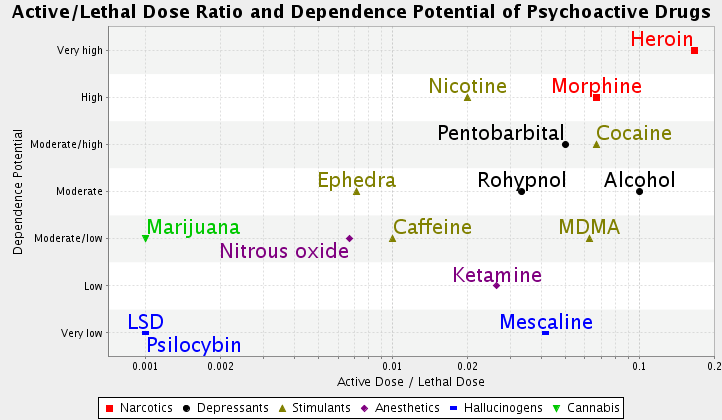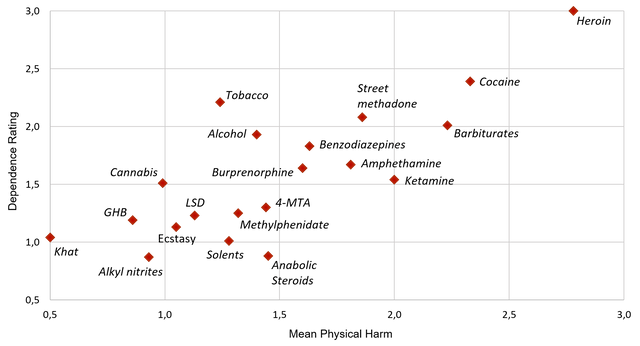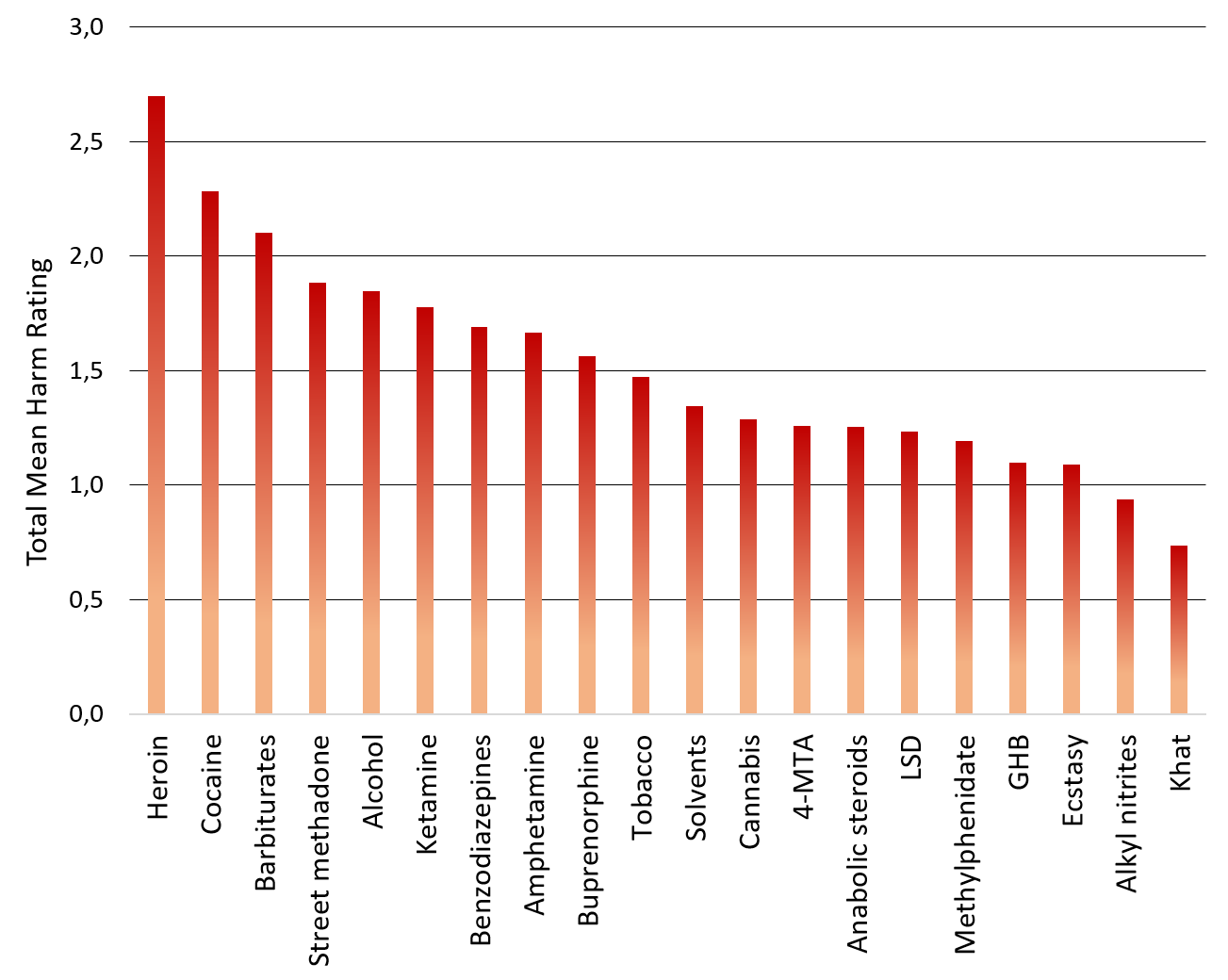You better know your Drugs! - A Review of a comprehensive Harm Assessment
Today I kick off a new series that will deal with misconceptions, which are rather widespread in the general public and should be tackled somehow. Let's jump in at the deep end and get started with the following topic:
How dangerous are Drugs?
First of I should mention that the term 'dangerous' is not specific and therefore difficult to evaluate. When you start to look up this question, you will quickly find that the harmfulness of drugs is usually reduced to their acute toxicity and their potential for dependence resp. addiction. For these parameters you can find some rather interesting graphics, like:

Source: Prof. R. S. Gable - CC content
Of course, after looking at this illustration, it is hardly impossible not to dive deeper. Here the lethale doses of various psychoactive compounds are shown on a logarithmic scale and plotted against a relative valuation of dependence. These were generated by questionnaires sent to professionals from selected disciplines like pharmacy, medicine, police, chemistry, etc.
What can be recognized from this graph right away is that legal psychoactive substances like alcohol, tobacco (nicotine) and caffeine are surprisingly bad ranked compared to many stigmatized and illegal drugs!
But does this graph provide a holistic picture of the initially asked question? Theoretically, the tendency of how much substances make you dependent could be investigated in a statistical approach, but therefor the data is lacking. Although it is possible to roughly estimate how many addicts of a substance exist, there is still a lack of information about the amount of people who have had contact with this substance but have not become addicted, parameters such as dosage form (injection, parenteral,...) and also about the individual number of contacts previous to addiction.
For this reasons, it seems indeed most convincing to have this ranking done by an assessment of a team of experts. But the x-axis, does only refer to acute toxicity, hence chronic toxic events and all other possible consequences of drug intake or abuse are neglected. I looked for a more comprehensive assessment and found a really fly publication (Ref.1).
Categories of Harm
The mentioned paper started with a classification of damages and consequences that may arise from drug use and abuse. The elaborated classification looks like this:
Physical Harm subdivided in:
A) acute toxic effects (e.g. sudden death from respiratory depression)
B) chronic toxic effects (e.g. lung diseases or psychosis)
C) intravenous harm (e.g. secondary harm like blood-borne viruses)Dependence subdivided in:
D) intensity of pleasure (relevant for street value and spread)
E) psychological dependence (lesser understood consequences)
F) physical dependence (boost tolerance, craving & physical changes)Social Harm subdivided in:
G) Intoxication (violent behaviour, accidents, a.s.o.)
H) Health-care costs (also social care, police, treatment, prevention)
I) Other social harms (damaging family and social life)
Based on this assessment matrix all participating experts were asked to score various substances for each of these nine parameters, using only a four-point scale:
0 = no risk
1 = some risk
2 = moderate risk
3 = extreme risk
Results & Conclusion
Averaging the results for every of the nine risk parameters over the whole group of consulted experts gave the distinct harm rating. In order to validate that their approach provides reproducible results, they established some rules that allow the use of certain (animal) studies and correlations and performed the assessment with two different groups of experts.
National Group of consultant psychiatrists from the Royal College of Psychiatrists' register for specialists in addiction
A mixed group of experts from the fields of Chemistry, Pharmacology, Forensic Science, Psychiatry, Medical Specialties
They compared the results of the two groups and found strong agreement with very little deviation. Hence their approach is legit and by far more comprehensive, let's have a look at their results on the total mean physical harm. For this I prepared their data in the same way as in the picture above:

Illustration self-made - Data taken from Ref. 1
Since there is no longer a logarithmic x-axis, the graph is more stretched in this direction and the chronic toxicity as well as the potential intravenous physical harm provide for slight shifts of individual dots along the x-axis. Although they tested not exactly the same compounds, the image is similar.
Again, you can see that alcohol and tobacco surprisingly are in the good midfield. However, the paper highlights an important issue:
'Tobacco and alcohol were included because their extensive use has provided reliable data on their risks and harms, providing familiar benchmarks against which the absolute harms of other drugs can be judged. However, direct comparison of the scores for tobacco and alcohol with those of the other drugs is not possible since the fact that they are legal could affect their harms in various ways, especially through easier availability.' - Ref. [1]
Ultimately, let's not forget about the third part of their harm assessment, the social harm! In order to judge the substances as holistically as possible, thus including also the assessed social harms, the total mean values were calculated from all nine parameters and the substances were ranked:

Mean values were determined without individual category weighting. For certain considerations, weighting may be reasonable. This leads to slightly altered sequences in the harmfulness sequence in different literature.
Illustration self-made - Data taken from Ref. 1
In summary, this approach does not allow to judge drugs purely on the basis of their inherent effects but rather generates an image in which factors such as legal availability and social acceptance could also be reflected.
Social harms do have significant contributions and must absolutely be taken into consideration. The enormous economic implications and also some general consequences from drug abuse are summarized in a detailed report. There it was estimated that every 1$ spent on prevention roughly saves 10$ by avoiding consequences of drug abuse in the first place!
mountain.phil28
References:
- Nutt, D.; King, L. A.; Saulsbury, W.; Blakemore, C. Development of a rational scale to assess the harm of drugs of potential misuse. The Lancet 2007, 369 (9566), pp. 1047-1053
- Gable, R. S. Acute toxicity of drugs versus regulatory status. In J. M. Fish (Ed.), Drugs and Society: U.S. Public Policy, 2006, pp. 149-162
Here is a link to the Reprint. - INCB: Economic consequences of drug abuse, a Report.
Being A SteemStem Member
It always amazed me how something that literally fucks your brain (psilocybin) can have such a low (probably zero) capacity to kill you. It's an amazing drug :D
Hahaha that's really true and pretty amazing. :-D
So you are actually doing medicinal chemistry? :P
...not related to this post but somehow yes. 😎🤗
very useful, thankx